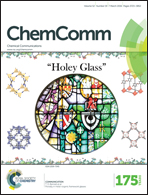Simultaneous cross-linking and p-doping of a polymeric semiconductor film by immersion into a phosphomolybdic acid solution for use in organic solar cells†
Abstract
Poly[N-9′-heptadecanyl-2,7-carbazole-alt-5,5-(4′,7′-di-2-thienyl-2′,1′,3′-benzothiadiazole)] (PCDTBT) is shown to be simultaneously cross-linked and p-doped when immersed into a phosphomolybdic acid solution, yielding conductive films with low solubility that can withstand the solution processing of subsequent photoactive layers. Such a modified PCDTBT film serves to improve hole collection and limit carrier recombination in organic solar cells.


 Please wait while we load your content...
Please wait while we load your content...